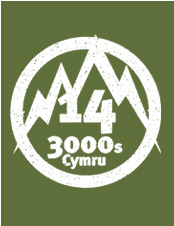
back to archiveThe 16th peak
With the advent of more detailed metric mapping by the Ordnance Survey in the late1970's and early 1980s, came the realisation that the 14 Peaks making up the Welsh 3,000 footers, should in fact be 15, as the old imperial contour height of 2,975 ft given for Garnedd Uchaf had been updated to 926 metres (3,038 feet). This affected everybody's attempt on the Welsh 3s, as evidenced by Joss Naylor who excluded Garnedd Uchaf during his June 1973 record of 4 hours 46 minutes. The present day record of 4 hours 19 minutes set in 1988 by Colin Donnelly included this 15th Welsh 3,000 ft summit.
However, should the Welsh 3,000 footers include a 16th summit, that of Castell y Gwynt in the Glyderau? This fine upthrust of rock has recently been surveyed for its re-ascent and dependent upon the criteria that is adopted for Welsh 3s to be included; this summit should now be considered the 16th 3,000 ft mountain in Wales.
Whilst subjectivity for inclusion is sometimes adopted, use of a prominence criterion allows a definitive list of Welsh 3s to be contructed. Many people consider 30 metres (approximately 100 ft) to be an acceptable re-ascent value; this is used for Alan Dawson's Hewitts and Murdos. However, Wales' history of classification favours a 50 ft rise on all sides to denote separate mountain status, and this has now been metricised to 15 metres. The Welsh peaks over 2,000 ft have been listed using this 50 ft / 15 m criterion since Arthur St George Walsh in the late 1920s, up until the present day, as evidenced in John and Anne Nuttall's Cicerone guide to 'The Mountains of Wales'.
A rudimentary survey with a staff and fixed spirit level had previously been conducted on Castell y Gwynt, most notably by Dewi Jones, who concluded this peak has more than 15 metres of rise from its connecting bwlch to its summit. As Castell y Gwynt rises very steeply from its bwlch, the terrain is difficult to survey and would require more sophisticated surveying equipment to determine a more accurate result.
In July 2007, along with Dewi, we made our way up onto the Glyder plateau. With us was a Leica Disto A8 laser measurer. After we had located the position of the bwlch, the Disto was fixed to a tripod. Dewi volunteered to clamber up to the summit of Castell y Gwynt, from where he aligned a reflective board with the highest part of rock. John set the equipment to go and out shone a laser beam that hit the reflective board. The Leica Disto A8 measures distance and angle of inclination / declination, and then computes vertical height difference from these data. We soon ascertained that Castell y Gwynt has a vertical height gain of 15.95 metres (52 feet 4 inches) from its connecting bwlch with Glyder Fach to its summit. Repeat measurements confirmed the re-ascent to be close to 16m.
Castell y Gwynt is now listed in the 3rd edition of the Nuttall's Welsh guide and dependent upon one's view of the re-ascent criterion to adopt, should in future form an integral part of the Welsh 3s and take its deserved place as the 16th Welsh 3,000 ft summit.
Postscript: For those wishing to know more about this and our other surveys, a detailed survey report is posted on the RHB (Relative Hills of Britain) website at: http://groups.yahoo.com/group/rhb/ Access requires signing in to belong to the RHB users group, this is free of charge.
John Barnard, Graham Jackson, Myrddyn Phillips.




